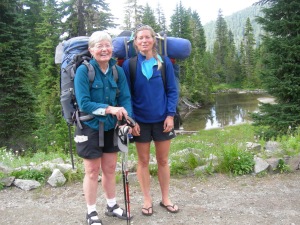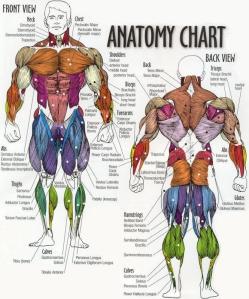Gentle Reader,
The Goodwill Games brought 2300 athletes from 54 countries to Seattle in the summer of 1990. My husband, Don Bell, chair of the public forum, Target Seattle: Preventing Nuclear War, in 1982, helped organize the representatives to the games from the Soviet Union. Our house, a few blocks from the University of Washington football stadium where the opening ceremonies were held, was full of Soviets, young Russians in their 30s and a few Uzbeks from our sister city, Tashkent. During the eight years between the first events in ’82, many groups traveled to and from the Soviet bloc including cooks (Peace Table), a team making and taking prosthetics and organizing competitive handicapped soccer matches here and abroad to name just a couple. Many had been in our home.
In the middle of this pre-Goodwill Games opening swirl, my youngest daughter, Ruth and I worked in our spacious dining room preparing the food for our 13 day back packing trip on the 95 mile Wonderland Trail around Mt. Rainier. Visiting Soviets–Uzbek and Russian–were mildly curious as we assembled a large metal bowl full of homemade granola and protein powder and then filled zip lock bags for each morning. A second bowl contained all the ingredients for our favorite gorp which we mixed by hand, digging deep into the M & M’s, roasted almonds, sunflower seeds, dried cherries, peanuts and dried plums. Salami sticks, blocks of hard cheese, rye crackers were divided for lunches. We put together mixtures for the evening meals: peanut butter soup (too rich) and other quick meals, not all freeze dried.
My next youngest daughter, Eleanor, arrived a day before our early departure for the Ranger Station where we obtained our permit and assigned camping spots along the route. She lived in Berkeley where she was in graduate school and took the train up to join us.
Less than a year earlier, I herniated disc L5 and began the therapies to get myself to this point. We divided the gear, a 3 person dome tent, stove, sleeping bags, mats, clothes and food so each had about 36 pounds. The girls probably carried more than I did. I did not have hiking poles which turned out to be foolish. I now use them on every hike except the short 3 – 4 mile ones in the city parks.
Our permit sent us counter clock wise around the mountain starting at Mowich Lake in the upper north west corner. Others had secured camping spots high up on the ridges. We had to settle for the valleys of the Mowich River, the North Puyallup and the South Puyallup rivers, Paradise River, Nickel Creek with Summerland the only up-slope campsite. Our disappointment turned into delight as we were on top of the world each mid day and could skinny dip in the high lakes unnoticed. We planned food pickups at Longmire where a car was parked with the next section’s food in the trunk, and again at Sunrise where Don was to meet us with the last segment’s food stash.
I fared well hiking carefully, thinking Pilates moves with each step. I favored the left leg worrying that it would not sustain strength over the full 13 days. Eleanor suffered knee pain from the extreme up and down each day. We descended 2500 ft our first day, carrying full packs. The next morning we gained 2400 ft by lunch time, took a dip in Golden Lake and descended 1400 ft to our riverside camp site.  I’d been training on stair cases and was managing well. Eleanor was having so much trouble; she decided to leave the hike and took the car home from the Longmire parking lot. After picking up a hiking stick and salty gorp (we forgot the need for extra salt when sweating so much), Ruth and I got our campsite settled and then hitched a ride up to Paradise lodge in a camper van from the Narada Falls visitor overlook. Enjoying a pitcher of beer in the bar at Paradise, we eves dropped on a group from Minnesota just down from summiting Mt. Rainier. The flatlanders had a tough time with the altitude, and a couple of them could not make the top. I realized I had no intention of ever climbing a snow capped mountain. Little did I know then that I would attempt Mt. Shasta in 2005 reaching 13,000 ft.
I’d been training on stair cases and was managing well. Eleanor was having so much trouble; she decided to leave the hike and took the car home from the Longmire parking lot. After picking up a hiking stick and salty gorp (we forgot the need for extra salt when sweating so much), Ruth and I got our campsite settled and then hitched a ride up to Paradise lodge in a camper van from the Narada Falls visitor overlook. Enjoying a pitcher of beer in the bar at Paradise, we eves dropped on a group from Minnesota just down from summiting Mt. Rainier. The flatlanders had a tough time with the altitude, and a couple of them could not make the top. I realized I had no intention of ever climbing a snow capped mountain. Little did I know then that I would attempt Mt. Shasta in 2005 reaching 13,000 ft.
Hiking around Mt. Rainier weaves in and out of civilization and wilderness. Within 200 yards of a paved overlook, crowds of summer visitors trip along in high heels, flip flops, pushing strollers, tipping back cokes and munching on chips. Into this scene emerging from 4 days in total wilderness appear 3 women, sweaty headbands, heavy boots and packs, unwashed faces and unkempt hair. We did not dally, but pushed through the milling groups to find the forest trail again. Only at Longmire and Paradise did we take advantage of the amenities.
By day 7, my right leg and hip were becoming so painful it hurt to take each step. The right side had compensated for the weaker left leg and ankle. Using my new walking stick with each left step put more stress on the right side. It was an eleven hour day covering eleven miles, up over snow fields and through spectacular fields of flowers, high bubbling streams, and alpine moon scapes above the timber line. One special moment I remember all these years later, I lay down on the trail to rest just a few feet from a large rust, grey and back marmot slowly nibbling his way across our path to the lupine beyond. We could hear him ripping flower heads and chewing. Carrying my stick in both hands and putting each foot down as evenly balanced as I could, we finally descended into Summerland in the dark, head lamps locating a camping spot. All I could do was get into the tent and stick my aching feet straight into the air. We managed to fix dinner and were sound asleep without seeing the incredible beauty that awaited us in the morning.
From Summerland to the White River camp ground is a short distance. Thy day was hot and clear. In the wash house, we washed our hair hoping to look presentable for our men who were meeting us in the late afternoon. It was August 8. We began the 2000 ft. ascent in bright sunshine. Half way up the 2000 ft gain from White River to Sunrise, heavy weather caught us. Clouds, thunder and lightning moved in quickly followed by hail. The alpine trees are so short at that elevation, they offered no protection. We put on everything we had to keep dry and warm and hurried up the last couple of miles, a stair case to the Sunrise parking lot to find Don and Ruth’s boyfriend sitting in the car with the windshield wipers going full blast. They convinced us to abandon the last segment of the hike, 35 of the 95 miles still to go. When we got to the Mowich Lake parking lot to retrieve our car, clear sky and full sun greeted us. Mt. Rainer makes its own weather and the storm was confined to the Sunrise side of the mountain So disappointing.
Persuading me to quit was not too difficult. I doubted my ability to do the last 35 miles. That remaining section of the Wonderland Trail haunted Ruth and me. We tried again to do it from Mowich to Sunrise in 2000 and were snowed out again on August 10th. Finally after I had trained and climbed Mt. Shasta in July of 2006, I felt was strong enough to carry a pack, and we completed the Northern loop in August. Our circumnavigation of the mountain did not end on the Wonderland Trail. Those permits were all taken. We began in mist hiking in from Lake Eleanor through Grand Park, a little known back entrance to the Park from the north. The second day we walked in heavy wet weather, moisture coming up and in sideways from the water laden plants along the narrow underused trail. On the third day the sun broke out to reveal the most glorious infrequently visited section of the park, Yellowstone Cliffs. Climbing out of Carbon River to Seattle and Spray Parks in hot sun, we breathed the fragrant air, eyes feasting on a sea of wild flowers and deep green grass. Spreading our wet gear out on high rocks to dry,  Ruth and I read, sketched and languished lazily before finally hiking the last miles to meet our waiting family. We could now claim the Wonderland Trail, 95 miles of absolute glorious wilderness. My first 60 miles celebrated my 53rd birthday. The last segment celebrated my 68th.
Ruth and I read, sketched and languished lazily before finally hiking the last miles to meet our waiting family. We could now claim the Wonderland Trail, 95 miles of absolute glorious wilderness. My first 60 miles celebrated my 53rd birthday. The last segment celebrated my 68th. 
This blog post is a reminiscence of triumph over injury, of doing a great physical activity against all odds. I know you have had similar triumphs. I hope you are inspired to keep moving. Do not give up. Leave a comment with your story.
Be Well, Do Well. Keep Moving,
Betsy
206 933 1889


 looked at my Magnetic Resonance Imaging—MRI, he declared my bones to be poor candidates for surgery. They already looked worn out at age 53.
looked at my Magnetic Resonance Imaging—MRI, he declared my bones to be poor candidates for surgery. They already looked worn out at age 53.



